
Angra do Heroísmo, or simply Angra, is a city and municipality on Terceira Island, Portugal, and one of the three capital cities of the Azores. Founded in 1478, Angra was historically the most important city in the Azores, as seat of the Bishop of the Azores, government entities, and having previously served as the capital city of Portugal during the Liberal Wars. The population in 2011 was 35,402, in an area of 239.00 km2. It was classified as a World Heritage site by UNESCO in 1983.
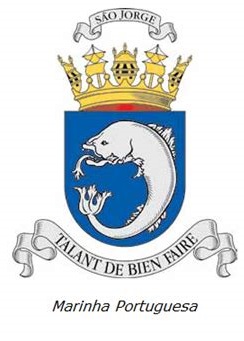
The Portuguese Navy, also known as the Portuguese War Navy or as the Portuguese Armada, is the navy of the Portuguese Armed Forces. Chartered in 1317 by King Dinis of Portugal, it is the oldest continuously serving navy in the world; in 2017, the Portuguese Navy commemorated the 700th anniversary of its official creation.

The Battle of Matapan, also known as the Battle of Cape Matapan, took place on 19 July 1717 off the Cape Matapan, on the coast of the Mani Peninsula, now in southern Greece. The naval battle was between the Armada Grossa of the Republic of Venice, supported by a mixed squadron of allied ships from Portugal, the Papal States and Malta, and the Ottoman fleet, under Kapudan Pasha Eğribozli Ibrahim Pasha.

Fafe is a municipality in the northern Portuguese district of Braga. The population in 2021 was 48,502, in an area of approximately 219.08 square kilometres (84.59 sq mi). The city itself had a population of 15,703 in 2011. The present mayor is Antero Barbosa, elected by the Socialist Party. The municipal holiday is May 16.

Lagoa is a city and municipality in the district of Faro, in the Portuguese region of Algarve. The population of the municipality in 2011 was 22,975, in an area of 88.25 km2. Its urban population, in the city of Lagoa proper, is 6,100 inhabitants. An important travel destination, its coast has won numerous accolades. Marinha Beach was considered by the Michelin Guide as one of the 10 most beautiful beaches in Europe and as one of the 100 most beautiful beaches in the world.

The French frigate Minerve was originally launched in 1788 for the Portuguese Navy, where she served under the dual names of Nossa Senhora da Vitória and Minerva. The French Navy captured and renamed her in November 1809, after which she played a notable role in the Indian Ocean campaign of 1809-1811, participating in the defeat of a Royal Navy frigate squadron at the Battle of Grand Port, but at the surrender of Mauritius in December 1810, the ship was handed over to the British, and seems to have been broken up soon afterwards.
The Battle of Calicut took place between the Portuguese ship of the line Nossa Senhora da Misericórdia, commanded by João de Melo Saraiva and 21 Maratha ships that attempted to conquer the city of Calicut. The Portuguese were victorious and managed to make the Marathas retreat.
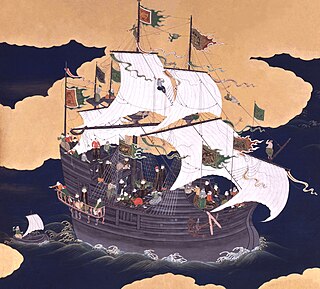
The Nossa Senhora da Graça incident (ノサ・セニョーラ・ダ・グラサ号事件), alternatively called the Madre de Deus incident (マードレ・デ・デウス号事件), was a four-day naval battle between a Portuguese carrack and Japanese samurai junks belonging to the Arima clan near the waters of Nagasaki in 1610. The richly laden "great ship of commerce", famed as the "black ship" by the Japanese, sank after its captain André Pessoa set the gunpowder storage on fire as samurai overran the vessel. This desperate and fatal resistance impressed the Japanese, and memories of the event persisted even into the 19th century.
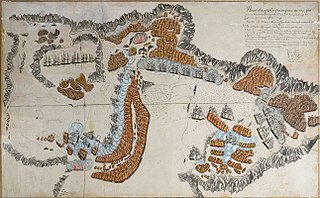
The Battle of the Tiger's Mouth was a series of engagements between a Portuguese flotilla stationed in Macau, and the Red Flag Fleet of the Chinese pirate Ching Shih, led by her second-in-command, Cheung Po Tsai - known to the Portuguese as Cam Pau Sai or Quan Apon Chay. Between September 1809 and January 1810, the Red Flag Fleet suffered several defeats at the hands of the Portuguese fleet led by José Pinto Alcoforado e Sousa, within the Humen Strait - known to the Portuguese as the Boca do Tigre - until finally surrendering formally in February 1810. After her fleet surrendered, Ching Shih surrendered herself to the Qing government in exchange for a general pardon, putting an end to her career of piracy.

The Fort of Nossa Senhora das Mercês de Catalazete, also known as the Fort of Catalazete, is located on the right bank of the River Tagus estuary in the municipality of Oeiras in the Lisbon District of Portugal. The fort dates back to 1762, when a small battery was erected on a site between the Fort of São Julião da Barra and the Fort of Santo Amaro do Areeiro, with the purpose of strengthening the defence provided by those two forts.

Pedro I was a ship of the line of the Imperial Brazilian Navy. It was a third-rate, three-masted, two-decked, 74-gunned sailing ship. The ship was built by Antônio da Silva in the Bahia Navy Arsenal in Salvador for the Portuguese Navy in Colonial Brazil in 1763. First named Santo António e São José, it took part in several naval actions in the decades after its construction such as the bombardment of Algiers in 1784.
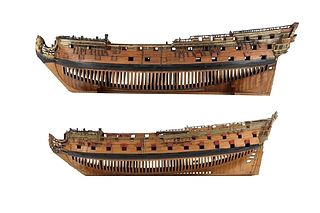
Nossa Senhora da Vitória was a 74-gun third-rate ship of the line of the Portuguese Navy, built and launched in Lisbon on 19 August 1735.

The siege of Colonia del Sacramento took place between October 1735 and September 1737, during the Spanish–Portuguese War (1735–1737).

Nossa Senhora da Graça, commonly known as Fénix, was a 46-gun frigate of the Portuguese Navy, launched in Salvador on 13 August 1787. The frigate was seized by the French in 1807 during the Invasion of Portugal during the Napoleonic Wars. In 1808, the frigate was recaptured and returned to Portuguese service. In 1819, the frigate was no longer deemed serviceable and was burned.

The Battle of Surat took place on 2 February 1704, off Surat, India, Arabian Sea, when a Portuguese squadron of one ship of the line and seven frigates, commanded by D. António de Meneses, defeated an Omani squadron of nine ships of the line and frigates.
The Battle of Mamora (1696) took place in the summer of 1696 between the Portuguese and Moroccan fleets off the coast of Mamora. The Portuguese left the battle victorious after repelling several Muslim vessels.
The action of 27 May 1802 was a single-ship action which took place in the Mediterranean Sea, when a 36-gun Portuguese frigate, commanded by the French capitão de mar e guerra João Luís de Seguin Deshon, was captured by a 44-gun Algerian frigate, commanded by the privateer Raïs Hamidou.
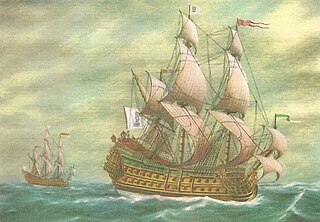
Nossa Senhora da Conceição was a 80-gun ship of the line of the Portuguese Navy, built and launched at Lisbon in 1701.
The action of 26 May 1789 was a minor naval engagement fought off Algiers, Mediterranean Sea, in which a small Portuguese division, commanded by coronel do mar José de Melo Breyner, spotted an Algerian xebec accompanied by a captured French ship, the Le Désir, of which he was forced to abandon and flee, pursued by the Portuguese brigantine Lebre.
The Cabinda Expedition was a military action carried out by Portugal, departing from Brazil, against British positions established in Cabinda, Angola. It was the only recorded conflict between the Portuguese and the British during the reign of King John V of Portugal.














